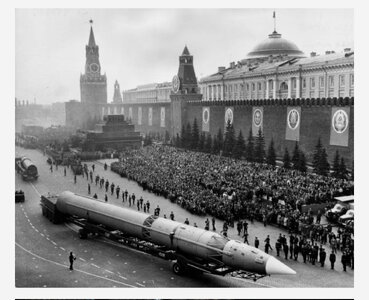
Thoughts on military parades and showy displays of brute strength. In April of 1953 The Cold War was Hot. Under the auspices of a U.N. resolution the United States was almost three years into The Korean War, a conflict that for most of us was made unreal from 1972 to 1983 and reruns ever since by the tragi-comedy “M*A*S*H” - a program that thankfully ran much longer than the 3 years, 1 month, and 2 days of the actual war, one which saw the estimated astronomical death toll of approximately 3.2 million (36,574 U.S. dead) killed.
Dwight D. Eisenhower was in the third month of his presidency in April of 1953, having defeated the Democratic Party’s candidate Adlai Stevenson in the election of 1952. “Ike” as the world had come to know him as had held the actual title of Five-Star General of the Army and Supreme Commander, Allied Expeditionary Force in World War II, the fight that, for decades at least, vanquished Fascism.
In that April, the 16th day to be precise, now president and no longer carrying gaudy titles or uniformed and festooned with medals but wearing a simple gray suit, Eisenhower spoke to the American Society of Newspaper Editors. His words were broadcast nationwide via television and radio. The speech, ultimately heard 'round the world, was titled “Chance for Peace.” Having actually served and known war first hand the General sought to tamp down the rhetoric of conflict and curtail the wastefulness of the rivalry with the Soviet Union in the Race to build bigger and more powerful bombs and missiles and tanks and bombers.
On that day Eisenhower spoke the following words: “Every gun that is made, every warship launched, every rocket fired signifies, in the final sense, a theft from those who hunger and are not fed, those who are cold and are not clothed. This world in arms is not spending money alone. It is spending the sweat of its laborers, the genius of its scientists, the hopes of its children. The cost of one modern heavy bomber is this: a modern brick school in more than 30 cities. It is two electric power plants, each serving a town of 60,000 population. It is two fine, fully equipped hospitals. It is some fifty miles of concrete pavement. We pay for a single fighter with a half-million bushels of wheat. We pay for a single destroyer with new homes that could have housed more than 8,000 people. . . . This is not a way of life at all, in any true sense. Under the cloud of threatening war, it is humanity hanging from a cross of iron.”
“This is not a way of life at all” the President and General said - Stalin had recently died and that Soviet authoritarian’s passing gave “Ike” hope that the long years of death and destruction (The Nazis had invaded Poland in 1939 and the fighting had been nigh constant across the globe since) might cease. Of course his hopes were not met as Vietnam and history and greed loomed as tripwires to multiple global rivalries, economic interests, and racial animosities continued to besot the planet with neo-colonial violence.
But the former Five Star General wanted no taunting of rivals nor stirring up of militaristic forms of national allegiance such as were the penchant of both the Nazi Fascists and the Soviet authoritarians. He knew all too well where such displays led. Even better he knew what the designers of those displays intended. The nation’s energies had been far too long dedicated in opposition to such theatrics and their poison fruit. Far too many had died in the fight against such sad, deception and chicanery. Eisenhower had been to war.
In his farewell speech on January 17, 1961 he famously warned — “we must guard against the acquisition of unwarranted influence, whether sought or unsought, by the military–industrial complex." No military parades in America friends. No kings. #NoKingsAnyDay
Text of the speech (Also known as “The Cross of Iron” Speech from the allusion made to the famous William Jennings Bryan “Cross of Gold Speech.”:
Dwight Eisenhower Cross of Iron Speech to the American Society of Newspaper Editors (text-audio)


